Table of Contents
ToggleIslamic art and architecture often use geometric patterns. IGPs (Islamic Geometric Patterns) have been used for millennia as ornamental elements on walls, ceilings, entrances, domes, and minarets, among other architectural elements. However, the absence of regulations and standards for the location of these ornaments often leads to their improper usage in terms of historical authenticity and architectural style compatibility.
It is also evident that religious inspiration was a driving force behind the widespread use of geometric patterns in art, architecture, and textiles. Mystics and theologians have utilized geometry as a contemplative tool because it provides a glimpse into the underlying order of the universe and the natural world. The cyclical motion of celestial bodies, which Plato referred to as the “music of the spheres,” is reflected on Earth in the inherent symmetries seen throughout nature, most notably in the world of flowers, whose proportions are determined by basic geometric principles.
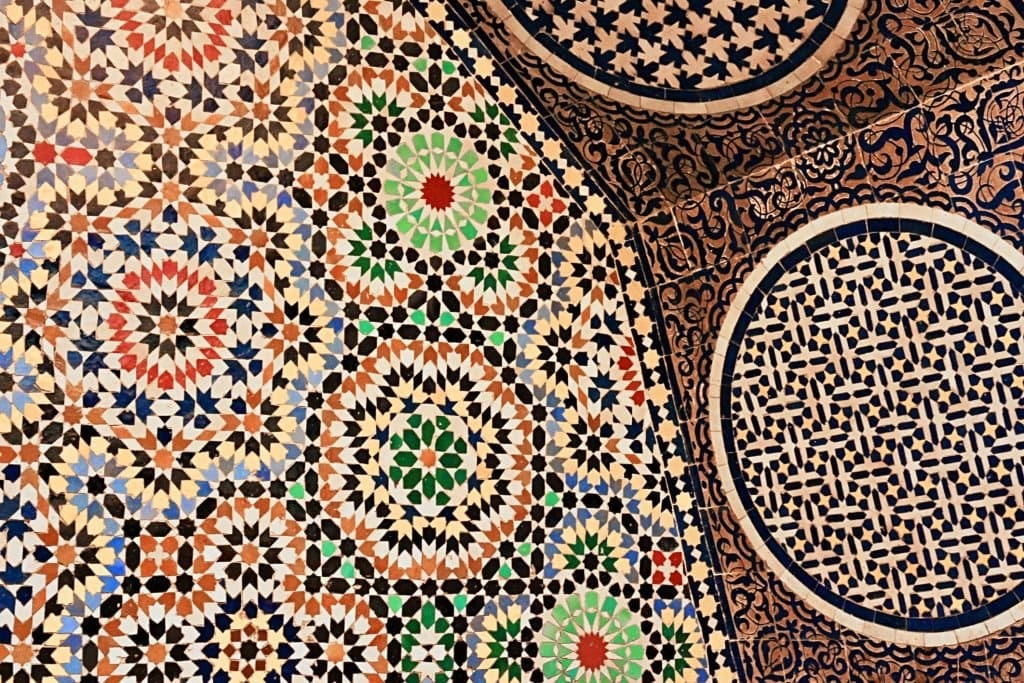
The term “cosmos,” from which we get “cosmetics,” means “adornment,” and religious structures decorated with floral and geometric patterns make viewers aware of the delicate harmonies between the natural world and the cosmos. It is uncommon to see images of individuals in Islamic art since it is believed by some to be a prohibited form of idolatry in the Islamic religion. Due to this, Islamic art has always been more concerned with calligraphy and geometric patterns than with sculpture and painting. This article discusses the types of Islamic geometric patterns as well as their symbolic significance.
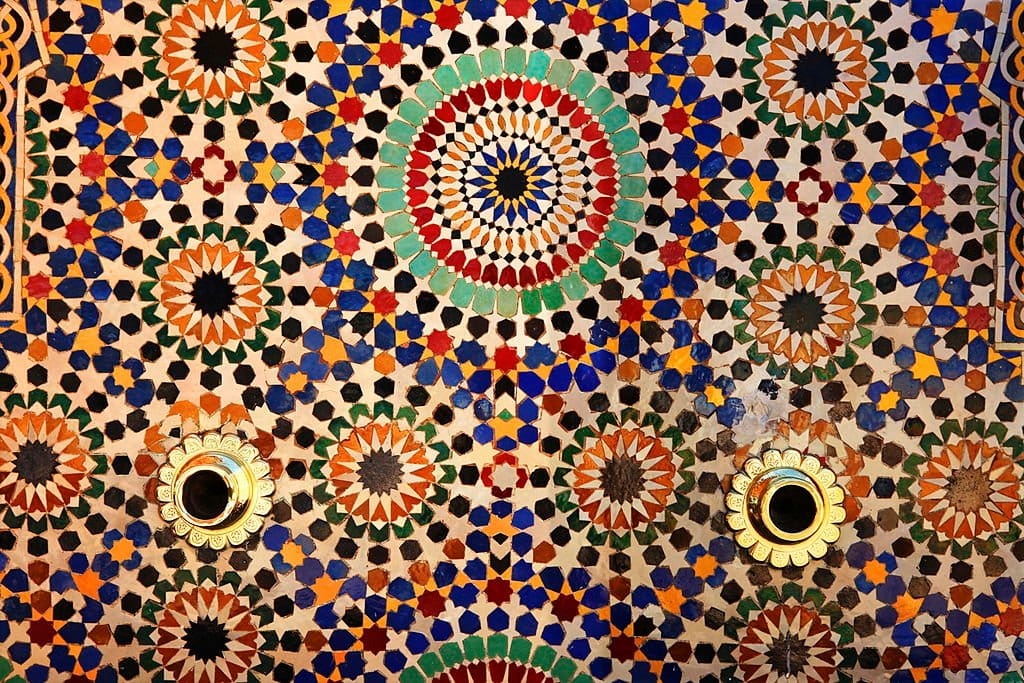
IGPs and their symbolic meanings
Utilization of geometric patterns extends back to the beginnings of Islam. In several ways, geometric patterns are considered to symbolize the endless essence of Allah. In actuality, calligraphy and geometric forms are not only used by Muslims in their artwork. Similar themes were also used by the ancient Romans, Greeks, and Sassanians. But the intricate styles of Islamic geometric art that we see today were developed by mathematicians and scientists in Islamic civilizations.
Geometric designs provide the artist with a great deal of creativity and expressiveness while still reflecting the order and oneness of the universe. These patterns elevated commonplace buildings to the status of remarkable works of art. This is another illustration of a major tenet of Islam: the belief that Allah and Islam fill life with beauty.
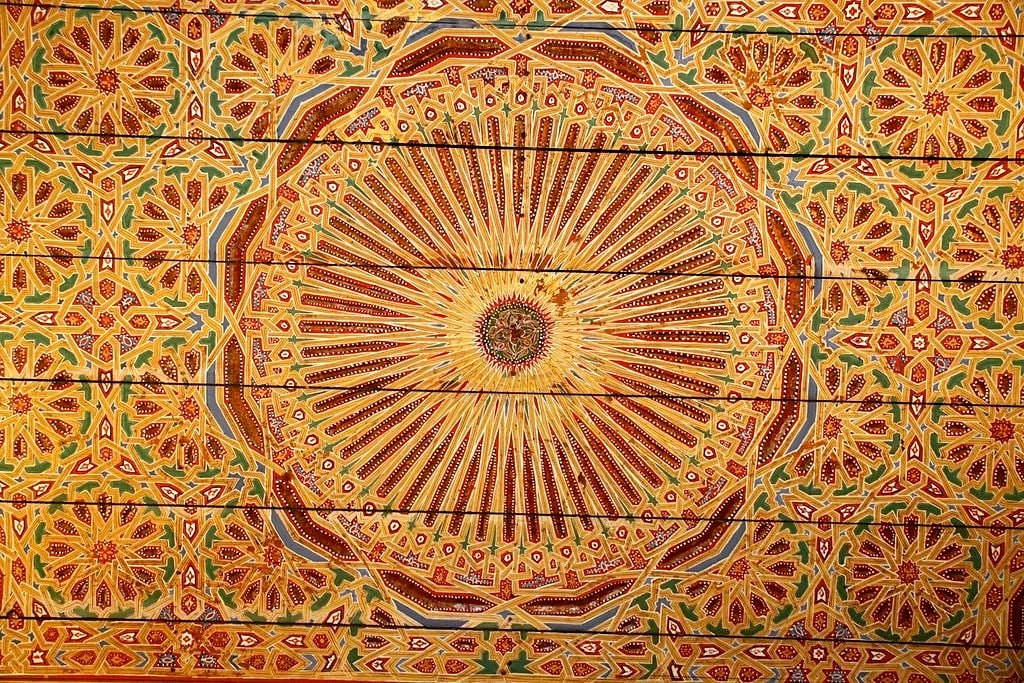
Citadels, mosques, mausoleums, and even dwellings have all been decorated with geometric patterns. They’re also a common material for mosaics and ornamental bowls. Circles, squares, various quadrilaterals, the six-pointed star, and other polygons make up the four primary categories of Islamic geometric patterns. The most fundamental forms are the circle and the square. For instance, circles have no beginning or end. The form of a star is derived from squares or triangles inscribed in a circle, and the eight-pointed star is a popular motif in Islamic art.
In Islamic art, the circle is the ultimate sign of oneness and the source of all variation in existence. Many classic Islamic designs begin with the natural partition of the circle into regular sections.
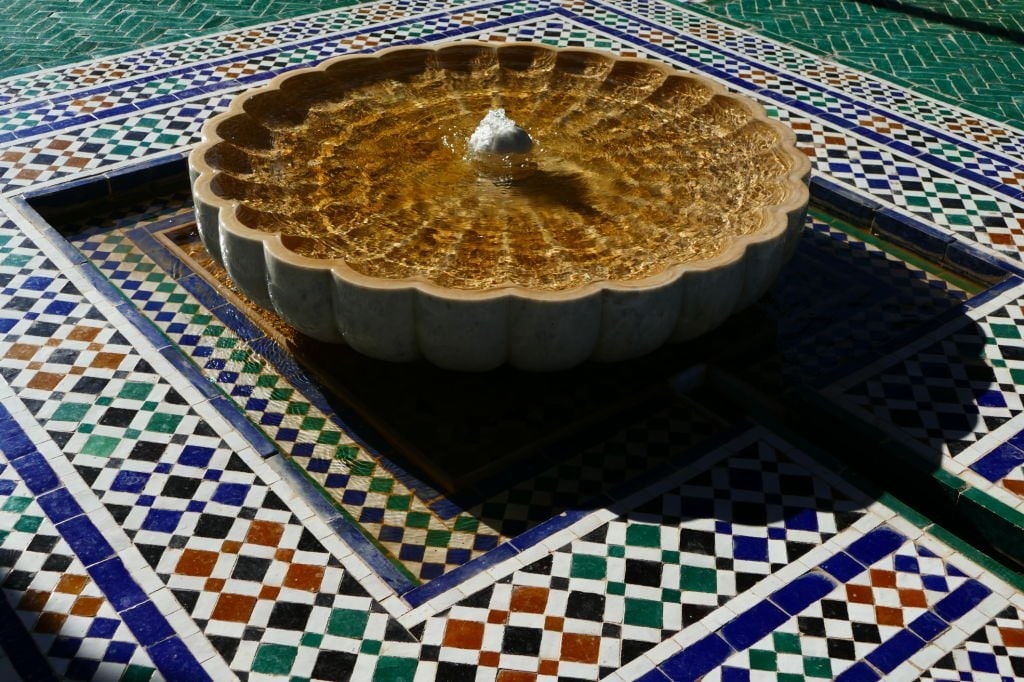
The shapes may be joined in an almost infinite variety of patterns and arrays. By repeating and extending the components, the basic elements produce complex designs with the potential for indefinite expansion.
As a consequence of the symmetry and precise proportions of all the elements, the geometric pattern-based decorations have a strong feeling of harmony and balance. Arabic script and calligraphy may also be used to embellish geometric designs. Verse and often whole chapters of the Quran were written using calligraphy. Sometimes, calligraphy was restricted to the unending repeating of a single sentence inside geometric bounds.
Islamic art reflects religious and cultural ideals. The fundamental ideas of the unity and oneness of Allah at the center of this religion are the source of the creative coherence of Muslim art. Islamic art does not seek to imitate anything currently in existence since any such attempt would only fall short of the perfection of Allah’s creation.
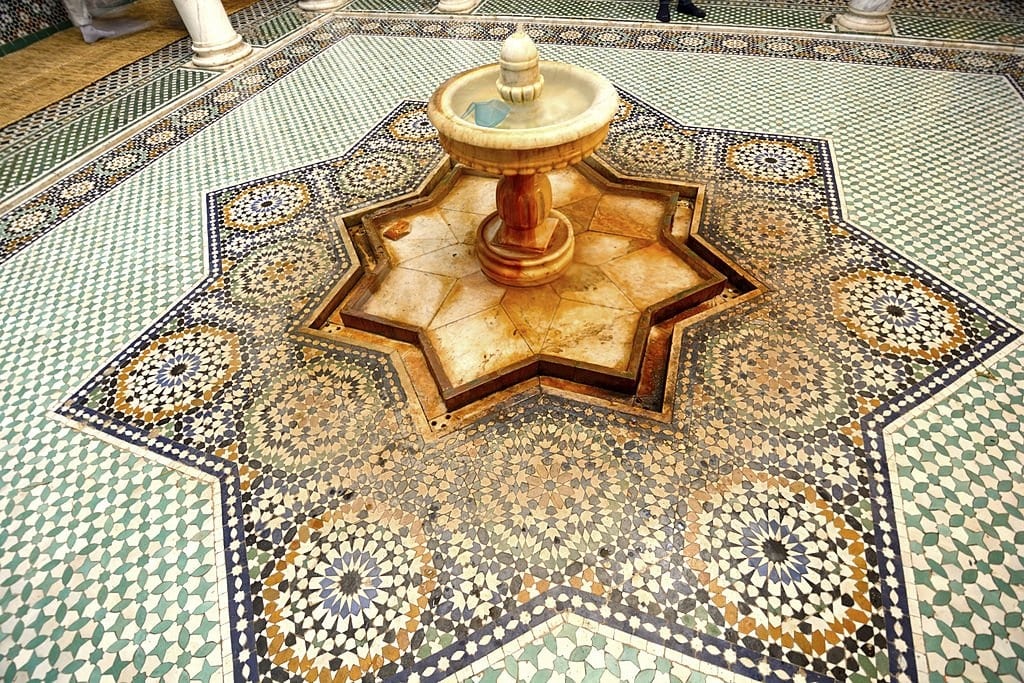
Islamic geometric patterns are a remarkable artistic tradition that has captivated the world for centuries. These beautiful designs, found in Islamic architecture, art, and manuscripts, showcase a perfect blend of mathematics, aesthetics, and spirituality. Islamic geometric patterns hold deep cultural and religious significance, reflecting the principles of unity, infinity, and divine order. In this article, we will delve into the history, symbolism, mathematical principles, key elements, influence, and legacy of these mesmerizing patterns.
Historical Origins
Islamic geometric patterns emerged during the Islamic Golden Age (8th to 14th centuries) and reached their zenith in various Islamic civilizations, including the Abbasid, Umayyad, and Mughal empires. Influenced by diverse cultural traditions, such as Persian, Arab, and Byzantine, these patterns became a hallmark of Islamic art and architecture. They adorned the walls, ceilings, and floors of mosques, palaces, and madrasas, creating breathtaking visual experiences.
Symbolism and Spiritual Significance
Islamic geometric patterns convey both artistic beauty and profound symbolism. They embody the Islamic concept of tawhid, or the belief in the unity of God. The repetition of geometric shapes and the absence of figurative representations highlight the transcendental nature of Islamic art, encouraging viewers to contemplate the divine order and cosmic harmony. These patterns also symbolize the infinite nature of God, as their intricacy and infinite replication suggest the boundless creative power of the Creator.
Mathematical Principles
Islamic geometric patterns are rooted in precise mathematical principles, reflecting the pursuit of knowledge and the importance of geometry in Islamic culture. The patterns are constructed using a compass and a straightedge, with the division of space into symmetrical grids and the repetition of basic geometric shapes, such as circles, squares, and stars. These shapes are combined and interwoven with precision to create complex patterns that mesmerize the viewer.
The mathematical principles employed in Islamic geometric patterns include symmetries such as reflection, rotation, and translation. These symmetries create a sense of balance and harmony within the patterns. Additionally, the concept of tessellation, where shapes fit together without gaps or overlaps, plays a crucial role in the creation of Islamic geometric patterns. This meticulous attention to mathematical precision is a testament to the Islamic emphasis on knowledge, order, and balance.
Key Elements and Designs
There are several fundamental elements and designs commonly found in Islamic geometric patterns. These include the rosette, a circular motif formed by the repetition of smaller shapes around a central point; the girih, intricate interlaced strapwork patterns; and the arabesque, flowing vegetal motifs. These elements are often combined and arranged in symmetrical compositions, creating mesmerizing tessellations that seem to effortlessly merge complexity and harmony.
The rosette, for example, is a prominent element in Islamic geometric patterns and is often used as a central motif. It symbolizes the unity and harmony of the universe, with the smaller shapes radiating outward from a central point, representing the divine source of creation. The girih patterns, characterized by their interlacing strapwork, create mesmerizing visual illusions and intricate designs that appear to weave in and out of each other. The arabesque motifs, inspired by the natural world, often depict leaves, vines, and flowers, symbolizing the beauty and abundance of creation.
Influence and Legacy
The beauty and sophistication of Islamic geometric patterns have left a lasting impact on the world of art and design. They have influenced various artistic traditions, from European Gothic architecture to contemporary art and graphic design. The mathematical principles employed in these patterns have also made significant contributions to mathematics, inspiring advancements in fields such as symmetry, tiling, and fractal geometry.
Read more: Persian tile work
Islamic geometric patterns continue to be celebrated and appreciated worldwide. Their timeless appeal transcends cultural boundaries, inviting people from all walks of life to marvel at their intricacy and symbolism. The legacy of Islamic geometric patterns serves as a reminder of the rich cultural heritage of Islamic civilizations and their contributions to the fields of art, mathematics, and architecture.
Types of Islamic Geometric Patterns
Islamic geometric patterns are renowned for their intricate beauty and mathematical precision. These mesmerizing designs, found in Islamic art and architecture, showcase a rich tradition that spans centuries and diverse cultures. From mosques to manuscripts, Islamic geometric patterns have adorned countless masterpieces, captivating the world with their symmetrical compositions and exquisite details. In this article, we will explore some of the prominent types of Islamic geometric patterns, each with its distinct characteristics and cultural influences.
Interlocking Stars
One of the most recognizable types of Islamic geometric patterns is the interlocking stars. This design features a series of stars, typically five or six-pointed, arranged in a way that their points interlock to create a seamless pattern. These stars often radiate from a central point and are repeated in a symmetrical manner, resulting in a captivating and balanced composition. This pattern is prevalent in various Islamic architectural elements, such as domes, windows, and tilework.
Interlocking stars are a captivating element within the realm of Islamic geometric patterns. These mesmerizing designs, often found in Islamic art and architecture, showcase the precise interplay of geometry, symmetry, and artistic creativity. Interlocking stars feature stars with multiple points arranged in a way that their points seamlessly interlock, resulting in intricate and harmonious compositions. In this article, we will delve into the beauty, symbolism, and cultural significance of interlocking stars within Islamic geometric patterns.
The Aesthetics of Interlocking Stars
Interlocking stars create visually stunning and mesmerizing compositions. These patterns often consist of stars with five or six points, though variations with more points can also be found. The stars are arranged in such a way that their points interlock, creating a sense of continuity and unity within the pattern. The repetition and precise alignment of the stars contribute to the overall balance and harmony of the design. The interlocking stars captivate the viewer with their intricate details, inviting a sense of awe and admiration.
Symbolism and Spiritual Significance
Interlocking stars hold deep symbolism and spiritual significance within Islamic art. They represent the unity and harmony found within the cosmos and reflect the Islamic concept of tawhid, the belief in the unity of God. The interlocking nature of the stars signifies the interconnectedness of all things, symbolizing the divine order and the interdependence of creation. These patterns inspire contemplation of the infinite and the transcendent nature of the universe, inviting viewers to reflect on the beauty and complexity of the world around them.
Cultural Influences and Historical Context
Interlocking stars have a rich historical and cultural background within Islamic art. They emerged during the Islamic Golden Age (8th to 14th centuries), influenced by diverse cultural traditions such as Persian, Arab, and Byzantine. Islamic civilizations, including the Abbasid, Umayyad, and Mughal empires, incorporated interlocking stars in their architecture, ceramics, manuscripts, and decorative arts. Notable examples include the intricate tilework in the Alhambra of Granada, Spain, and the beautiful star patterns adorning the domes of the Blue Mosque in Istanbul, Turkey.
Read more: What is muqarnas?
Mathematical Precision and Symmetry
Interlocking stars in Islamic geometric patterns exemplify the mathematical precision and symmetrical principles inherent in Islamic art. These patterns are constructed using compasses and straightedges, following precise geometric rules. The stars are arranged in symmetrical compositions, often with a central point from which they radiate. The repetition of stars and the symmetrical alignment of their points create a sense of order, balance, and mathematical harmony within the design.
Contemporary Applications and Influence
The timeless beauty and elegance of interlocking stars continue to inspire artists, designers, and architects worldwide. Contemporary applications of interlocking stars can be seen in various art forms, including modern Islamic calligraphy, graphic design, and interior decoration. The influence of interlocking stars can also be observed beyond Islamic art, inspiring patterns in diverse cultural contexts and artistic traditions.
Girih
Girih patterns are a unique type of Islamic geometric pattern characterized by intricate strapwork. Derived from the Persian word for “knot,” girih patterns consist of interlaced strap-like elements that create elaborate and visually stunning designs. These patterns often feature polygons, such as hexagons, octagons, and decagons, which are carefully interwoven to form complex geometric compositions. Girih patterns are commonly found in Persian and Central Asian Islamic art, adorning architectural elements like vaulted ceilings, screens, and ceramic tiles.
Arabesque
Arabesque patterns are another prominent type of Islamic geometric pattern. These designs draw inspiration from the natural world, featuring elements such as leaves, flowers, and vines. Arabesque patterns are characterized by their flowing, curvilinear forms, which often intertwine to create a rhythmic and organic composition. This type of pattern is commonly found in various Islamic art forms, including calligraphy, tilework, and woodwork. Arabesque patterns symbolize the interconnectedness of nature and the divine creation.
Tessellations
Tessellations are an integral part of Islamic geometric patterns. A tessellation is a repeated pattern of shapes that fit together without any gaps or overlaps. Islamic artists and mathematicians have explored a wide range of tessellation designs, using various shapes such as squares, hexagons, and octagons. These tessellating patterns create intricate, tile-like arrangements that cover surfaces with mesmerizing repetition. Tessellations can be seen in Islamic architectural elements, like floors, walls, and domes, as well as in decorative arts such as carpets and textiles.
Calligraphic Patterns
Islamic calligraphy plays a significant role in Islamic art and is often incorporated into geometric patterns. Calligraphic patterns feature beautifully stylized Arabic script, which is seamlessly integrated into the geometric composition. The verses from the Quran or other religious texts are carefully written and arranged to form intricate patterns that combine the elegance of calligraphy with the precision of geometry. These patterns can be seen in architectural elements, manuscripts, and decorative objects.
Conclusion
Islamic geometric patterns are a testament to the rich cultural heritage and artistic genius of Islamic civilizations. These intricate designs not only showcase the mastery of geometry but also convey profound spiritual and philosophical ideas. As we admire the mesmerizing beauty of Islamic geometric patterns, we gain a deeper understanding of the Islamic worldview, emphasizing unity, infinity, and divine order.
The legacy of Islamic geometric patterns continues to inspire artists, architects, and mathematicians, bridging the gap between art and science. By exploring and appreciating these patterns, we connect with a centuries-old tradition of aesthetic expression, intellectual curiosity, and spiritual contemplation. Islamic geometric patterns are a true testament to the power of art to transcend time, culture, and boundaries, inviting us to delve into the depths of their beauty and symbolism.
FAQ about Types of Islamic geometric patterns
Here are five frequently asked questions (FAQ) about types of Islamic geometric patterns:
What are the main types of Islamic geometric patterns?
Islamic geometric patterns encompass a wide range of designs. Some of the main types include interlocking stars, girih patterns, arabesque patterns, tessellations, and calligraphic patterns. These patterns showcase the intricate interplay of geometric shapes, symmetry, and cultural influences found in Islamic art and architecture.
How are interlocking stars different from other Islamic geometric patterns?
Interlocking stars refer to a pattern where stars with multiple points are arranged in a way that their points interlock to create a seamless design. This type of pattern often features a central point from which the stars radiate. In contrast, other patterns like girih, arabesque, tessellations, and calligraphic patterns have their own distinct characteristics, such as strapwork, flowing vegetal motifs, repeated tile-like arrangements, and integration of calligraphy, respectively.
Where can we see examples of girih patterns?
Girih patterns are prominently featured in Persian and Central Asian Islamic art and architecture. They can be found adorning architectural elements such as vaulted ceilings, screens, and ceramic tiles. Notable examples include the intricate geometrical designs in the mausoleum of Gur-e-Amir in Samarkand, Uzbekistan, and the exquisite tilework of the Jameh Mosque of Isfahan in Iran.
What are tessellations in Islamic geometric patterns?
Tessellations are a significant aspect of Islamic geometric patterns. They refer to the repeated arrangement of shapes that fit together without any gaps or overlaps. Islamic artists and mathematicians explored various tessellation designs, using shapes like squares, hexagons, and octagons. These tessellating patterns can be seen in architectural elements such as floors, walls, and domes, as well as in decorative arts like carpets and textiles.
How are calligraphic patterns incorporated into Islamic geometric designs?
Calligraphic patterns combine the elegance of Arabic calligraphy with the precision of geometric compositions. The verses from the Quran or other religious texts are carefully written and arranged to form intricate patterns. Calligraphy is seamlessly integrated into the geometric design, enhancing its aesthetic appeal and spiritual significance. Examples of calligraphic patterns can be found in architectural elements, manuscripts, and decorative objects throughout Islamic art.
These FAQs provide an overview of the main types of Islamic geometric patterns and their characteristics. Exploring the diverse range of patterns allows for a deeper understanding and appreciation of the intricate beauty and cultural heritage found in Islamic art.
